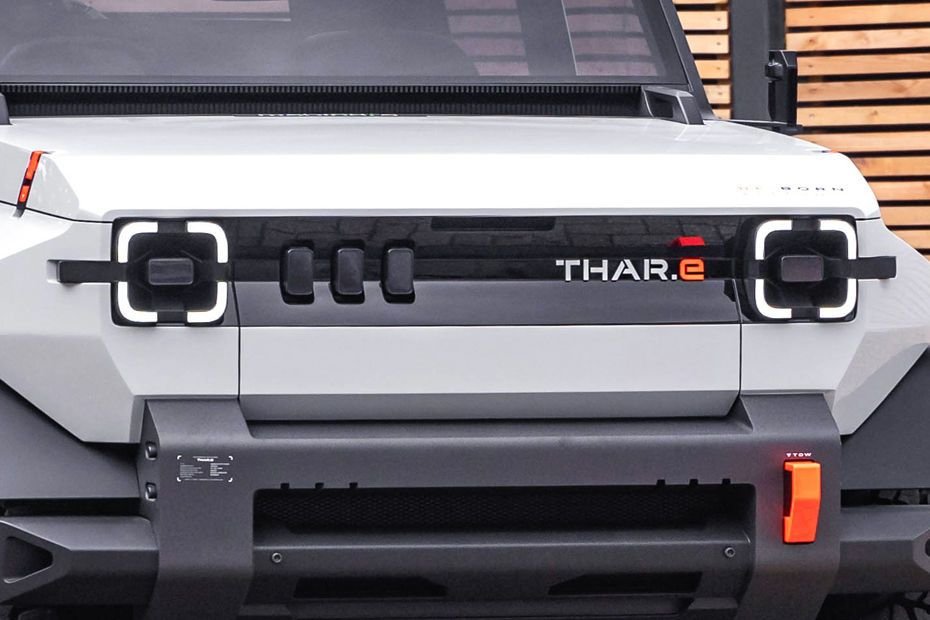The Mahindra Thar.ev is not just an electric car; it’s a statement piece. It takes the iconic Mahindra Thar, known for its ruggedness and off-road prowess, and electrifies it for a sustainable future. While it’s still a concept vehicle, it has generated significant buzz, so here’s a breakdown of what we know so far:

THAR-EV Exterior:
- Rugged yet refined: The Thar.e retains the classic Jeep-inspired design with a boxy silhouette, rounded headlights, and exposed hinges. However, modern touches like sleek LED lighting and flush door handles hint at its advanced nature.
- 5-door practicality: Unlike the current 3-door Thar, the concept boasts a practical 5-door setup, making it easier for passengers and cargo access.
- Adventure-ready: High ground clearance, chunky tires, and underbody protection ensure it can handle rough terrain.

THAR-EV Interior:
- Functional and familiar: The cabin retains the rugged and utilitarian feel of the Thar with exposed elements and water-resistant materials.
- Modern upgrades: A digital instrument cluster and a touchscreen infotainment system bring it up to date.
- Spacious and flexible: The 5-door layout and potentially foldable rear seats promise ample space for passengers and gear.

THAR-EV Performance:
- Electric powertrain: Details are still scarce, but expect a powerful electric motor with instant torque for thrilling off-road performance.
- Battery and range: Rumors suggest a 75kWh battery pack offering a range of over 400km, suitable for both on-road adventures and weekend getaways.
- Fast charging: Mahindra is likely to equip the Thar.e with DC fast-charging capability for convenient on-the-go charging.

THAR-EV Launch and Price:
- Expected launch: While dates are tentative, reports suggest a possible launch in India between 2025 and 2026.
- Price range: Expect a starting price around Rs. 20-25 lakh (ex-showroom), making it a premium offering in the electric SUV segment.

Impact and Significance:
- Game-changer for THAR-EV : The Thar.e has the potential to be a game-changer for electric vehicles in India, proving that eco-friendly doesn’t have to mean sacrificing adventure or style.
- Boosting EV adoption: Its popularity and rugged capabilities could attract new segments of car buyers towards electric vehicles.
- Future of Mahindra: The Thar.e showcases Mahindra’s commitment to electric mobility and its vision for a sustainable future.
Digging Deeper into the Electric Thar:
Technical aspects:
- Platform: The Thar.e might utilize Mahindra’s new ‘INGLO’ platform, designed specifically for electric vehicles. This could offer advantages like better battery integration and improved weight distribution.
- 4×4 capabilities: Mahindra has confirmed plans for a fully capable 4×4 system in the Thar.e, likely with dual electric motors for individual wheel control and enhanced off-road prowess.
- Regenerative braking: Expected to be a key feature for recovering energy during downhill driving and extending the range.
Mahindra Thar EV specs:-
| Specification | Expected Value |
|---|---|
| Dimensions | |
| Length | 3985 mm |
| Width | 1855 mm |
| Height | 1870 mm |
| Wheelbase | 2450 mm |
| Ground clearance | 250+ mm |
| Motor and Battery | |
| Battery capacity | 75-80 kWh |
| Motor power | 150-200 kW (200-270 hp) |
| Torque | 300-400 Nm |
| Drivetrain | 4WD |
| Performance | |
| 0-100 km/h | 8-10 seconds |
| Top speed | 150-180 km/h |
| Range | 400-450 km (WLTP) |
| Charging | |
| DC fast charging | 150-175 kW |
| Charging time (0-80%) | 30-40 minutes |
| Features | |
| LED headlights and taillights | Yes |
| Digital instrument cluster | Yes |
| Touchscreen infotainment system | Yes |
| Sunroof | Maybe |
| V2L capability | Maybe |
| Launch and Price | |
| Expected launch | 2025-2026 |
| Expected price | Rs. 20-25 lakh (ex-showroom) |
Challenges and concerns:
- Charging infrastructure: Limited availability of fast-charging stations, especially in remote areas, could be a hurdle for long-distance off-road trips.
- Range anxiety: While the promised range is decent, off-road driving tends to be more energy-intensive, potentially influencing user behavior.
- Price point: Premium pricing might limit the initial market reach and compete with established ICE-powered off-roaders.
Opportunities and potential impact:
- Boosting adventure tourism: The Thar.e’s eco-friendly appeal could attract a new generation of adventure seekers to explore environmentally sensitive areas.
- Technological advancements: The Thar.e could spur innovations in battery technology, charging infrastructure, and electric off-road vehicle development.
- Shifting market trends: By successfully combining ruggedness with zero emissions, the Thar.e could accelerate the acceptance of electric vehicles in India and beyond.
Additional angles to consider:
- Compare the THAR-EV to other electric off-road concepts like the Rivian R1S or Jeep Wrangler Magneto.
- Discuss the potential implications of the THAR-EV for Mahindra’s brand image and future vehicle designs.
- Explore the economic and environmental benefits of electric off-roaders compared to their fossil-fuel counterparts.
Going Beyond the Hype: A Critical Look at the Electric Thar
While the electric Thar has stirred excitement, let’s take a more critical lens to explore its promises and potential pitfalls:

Hype and Reality:
- Off-road prowess: Mahindra boasts of the THAR-EV 4×4 capabilities, but translating electric drivetrains for true off-road performance remains a challenge. Factor in potential weight gain from batteries and lack of low-range gearing, and questions arise about its ruggedness compared to its ICE sibling.
- Range anxiety: The promised range may seem impressive, but off-road driving, steep inclines, and extreme weather can significantly reduce it. Charging infrastructure in remote areas is also a crucial factor to consider.
- Premium pricing: The expected priceof THAR-EV tag may put it out of reach for many traditional Thar buyers. Mahindra needs to navigate the balance between premium features and affordability to broaden its appeal.
Environmental Impact:
- Battery production: While the Thar.e reduces tailpipe emissions, the environmental impact of battery production and disposal deserves attention. Sustainable sourcing and responsible recycling practices are crucial to minimize its ecological footprint.
- Charging sources: The clean image depends heavily on the source of electricity used for charging. Relying on fossil fuel-powered grids negates the environmental benefits. Promoting renewable energy sources is vital for true sustainability.
Market and Competition:
- First-mover advantage: If Mahindra plays its cards right, the THAR-EV could capture a significant share of the emerging electric off-road market. However, established players like Jeep and Rivian are also developing their own electric off-roaders, leading to intense competition.
- Shifting consumer preferences: While the adventure-seeking niche might embrace the THAR-EVthe broader market’s shift towards electric vehicles, especially compact THAR-EV SUVs, may pose a challenge.
Unanswered Questions:
- Final specifications: Detailed technical specifications like torque, battery capacity, and charging times are still under wraps. These will play a crucial role in assessing its true capabilities and performance.
- Interior design and features: The glimpses of the interior suggest functionality, but details about amenities, technology integration, and comfort remain unclear.
- Customization options: The Thar’s popularity stems partly from its wide range of customization options. Will the electric version offer similar possibilities for personalized upgrades?
Deep Dive: Unveiling the Potential (and Pitfalls) of the Electric Thar
Technological Innovations:
- V2L (Vehicle-to-Load) Technology: Rumors suggest the Thar.e might offer V2L functionality, allowing it to power external devices like camping equipment or even homes during emergencies. Explore the potential impact of this feature on outdoor adventures and disaster preparedness.
- Connectivity and Software: Mahindra THAR-EV could integrate advanced driver-assistance systems (ADAS) and off-road-specific software features. Discuss the safety and performance benefits of such technologies while raising concerns about potential privacy issues and software updates.
- Battery Innovation: Mahindra THAR-EV aims to develop solid-state batteries for future EVs. Highlight the potential advantages of this technology in terms of range, charging speed, and safety, and speculate on their possible inclusion in the Thar.e.
Social and Cultural Impact:
- Redefining Adventure: TheTHAR-EV could bridge the gap between eco-conscious travelers and off-road enthusiasts. Analyze how it might influence adventure tourism and promote responsible exploration of natural landscapes.
- Status Symbol vs. Sustainable Choice: Consider the potential for the Thar.e to become a status symbol for environmentally conscious individuals. Discuss the importance of balancing consumer choices with genuine environmental responsibility and ethical sourcing practices.
- Changing Perceptions of EVs: The THAR-EV ruggedness and off-road capabilities could challenge the stereotypical image of electric vehicles as merely city cars. Analyze its potential to change perceptions and broaden the appeal of EVs to a wider audience.
Economic and Political Landscape:
- Government Incentives and Policy: Government policies like subsidies and tax breaks can significantly impact EV adoption. Analyze how such initiatives could influence the affordability and success of the THAR-EV
- Local Manufacturing and Job Creation: Mahindra’s focus on domestic production could boost local manufacturing and create new jobs. Discuss the economic benefits and potential challenges of building a robust EV ecosystem in India.
- Geopolitical Considerations: The access to and reliance on critical materials like lithium for battery production raise geopolitical concerns. Explore the potential impact of resource scarcity and international relations on the future of EVs like the Thar.e.
1. Mahindra’s EV Ambition:
- Explore Mahindra’s broader electric vehicle strategy and how the Thar.e fits into their vision.
- Discuss their commitment to sustainability and their plans for expanding their EV lineup.
- Analyze their potential to become a major player in the Indian and global EV market.
2. Design and Interior Details:
- Go beyond the official glimpses and speculate on the Thar.e’s interior design based on trends and Mahindra’s design language.
- Imagine features like a panoramic sunroof, removable roof panels for ultimate open-air adventures, and waterproof interiors for easy cleaning.
- Discuss the potential for modular storage solutions, off-road accessories integration, and a rugged yet comfortable cabin.
3. The Technology Behind the Thrill:
- Delve deeper into the technical aspects of the Thar.e’s electric drivetrain, battery technology, and 4×4 system.
- Explain the potential benefits of features like torque vectoring for enhanced off-road performance.
- Discuss the challenges of integrating off-road capabilities with an electric platform and Mahindra’s solutions.
4. Charging Infrastructure and Range Anxiety:
- Analyze the current state of EV charging infrastructure in India and potential solutions for overcoming range anxiety for off-road enthusiasts.
- Explore innovative charging solutions like solar panels or portable chargers designed for remote locations.
- Discuss Mahindra’s plans for building a robust charging network and partnerships with other stakeholders.
5. The Thar.e and the Adventurer’s Ecosystem:
- Imagine how the Thar.e could integrate with a broader ecosystem of outdoor gear, camping equipment, and sustainable travel services.
- Discuss partnerships with eco-friendly tourism companies and adventure outfitters to cater to a specific market segment.
- Explore the potential for the Thar.e to become a central hub for planning and executing sustainable off-road adventures.
6. The Competition and the Road Ahead:
- Compare the Thar.e to other existing and upcoming electric off-roaders like the Rivian R1S and Jeep Wrangler Magneto.
- Analyze its potential advantages and disadvantages in terms of price, performance, and features.
- Discuss the challenges and opportunities Mahindra faces in a competitive market and their strategies for success.
7. Conclusion: A Charged Future for Adventure:
- Recap the key points of your article and emphasize the exciting potential of the electric Thar.
- Discuss its ability to redefine off-roading, promote sustainable travel, and cater to a new generation of adventurers.
- Conclude with a forward-looking statement about the future of the Thar.e and its impact on the automotive and adventure landscapes.
Unwrapping the Electric Thar’s Mystery:
1. Beyond Specs: The Emotional Connection:
- Explore how the Thar.e might tap into the nostalgia and heritage associated with the original Thar, offering a familiar thrill with a greener conscience.
- Discuss the potential for customization and personalization, allowing owners to express their adventurous spirit through unique modifications.
- Analyze the marketing strategies that could position the Thar.e as an emblem of eco-conscious exploration and a symbol of personal liberation.
2. The Soundscape of Silence:
- Imagine the unique sensory experience of off-roading in a silent electric Thar.e, focusing on the sounds of nature and the heightened awareness of the environment.
- Discuss the potential for curated soundscapes or musical collaborations to personalize the driving experience and enhance the emotional connection with the journey.
- Explore the challenges and ethical considerations of adding artificial sounds to electric vehicles, balancing safety and authenticity.
3. Tech Meets Terrain: Innovation for the Untamed Path:
- Delve into the potential for AI-powered off-road assistance features that adjust power delivery, traction control, and even route planning based on real-time terrain analysis.
- Discuss the possibilities of integrating drone technology for scouting ahead, monitoring surroundings, and capturing breathtaking cinematic shots of the adventure.
- Analyze the potential impact of these features on the balance between human skill and technological support in off-road experiences.
4. Community and Collaboration: The Future of Exploration:
- Imagine online communities of Thar.e owners sharing routes, charging tips, and repair hacks, fostering a spirit of collaboration and mutual support.
- Discuss the potential for organized eco-tourism expeditions led by experienced Thar.e owners, promoting responsible exploration and environmental awareness.
- Analyze the role of social media in connecting the Thar.e community, sharing stories, and inspiring others to embrace sustainable adventure.
5. Beyond the Firewall: Hacking the Thar.e:
- Explore the potential for aftermarket modifications and performance upgrades by independent specialists, catering to enthusiasts who crave bespoke experiences.
- Discuss the challenges of balancing open-source customization with manufacturer warranty and safety concerns.
- Analyze the ethical implications of modifying an electric vehicle and the potential environmental impact of performance enhancements.
6. The Road Less Traveled: Pushing the Boundaries:
- Imagine the Thar.e tackling extreme terrains like the Himalayas, deserts, or rainforests, pushing the limits of electric drivetrains and human ingenuity.
- Discuss the potential for research and development projects utilizing the Thar.e platform for testing new technologies and collecting data in challenging environments.
- Analyze the role of electric off-roaders in promoting sustainable exploration and scientific research in remote and ecologically sensitive areas.

